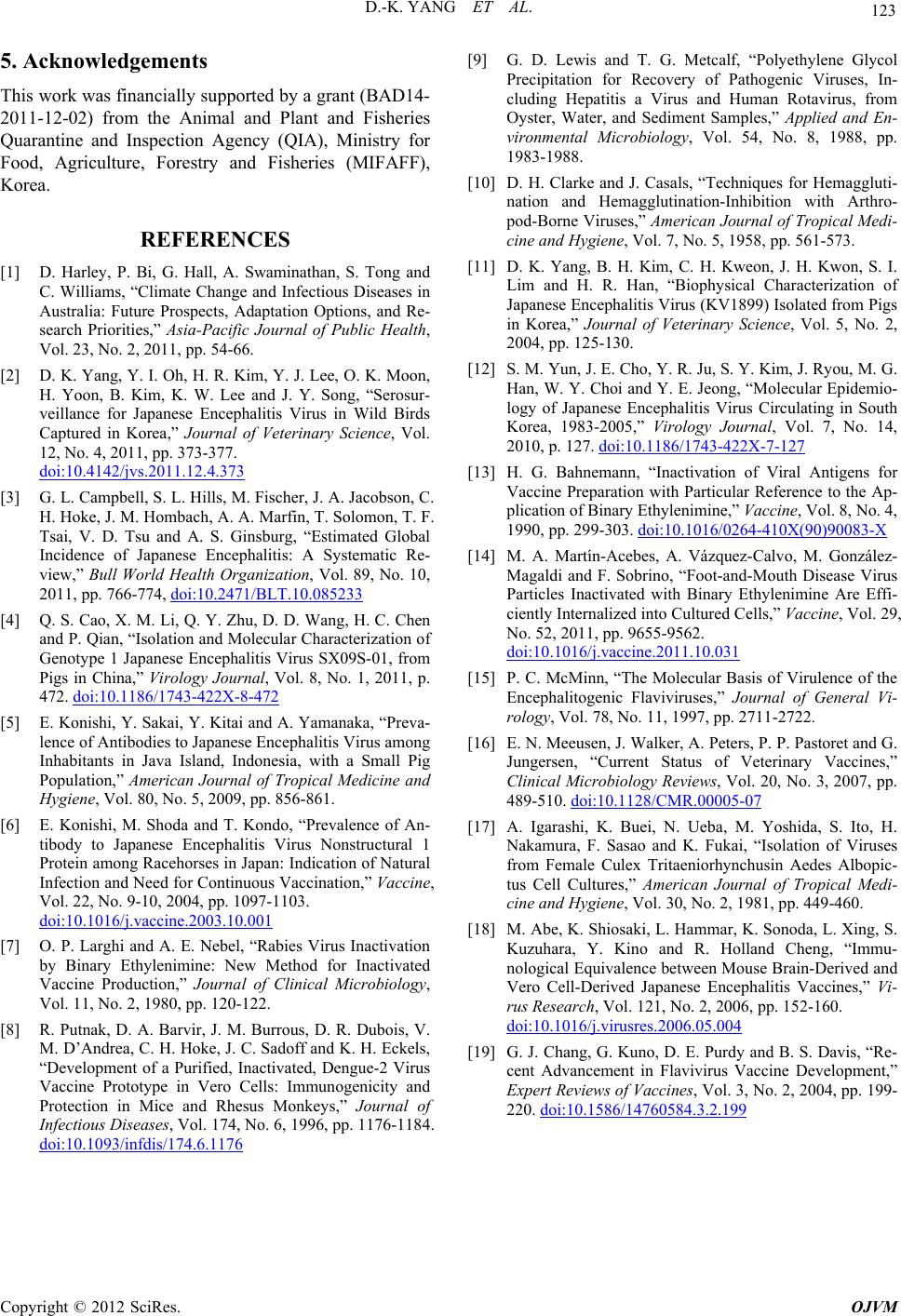
D.-K. YANG ET AL.
Copyright © 2012 SciRes. OJVM
123
5. Acknowledgements
This work was financially supported by a grant (BAD14-
2011-12-02) from the Animal and Plant and Fisheries
Quarantine and Inspection Agency (QIA), Ministry for
Food, Agriculture, Forestry and Fisheries (MIFAFF),
Korea.
REFERENCES
[1] D. Harley, P. Bi, G. Hall, A. Swaminathan, S. Tong and
C. Williams, “Climate Change and Infectious Diseases in
Australia: Future Prospects, Adaptation Options, and Re-
search Priorities,” Asia-Pacific Journal of Public Health,
Vol. 23, No. 2, 2011, pp. 54-66.
[2] D. K. Yang, Y. I. Oh, H. R. Kim, Y. J. Lee, O. K. Moon,
H. Yoon, B. Kim, K. W. Lee and J. Y. Song, “Serosur-
veillance for Japanese Encephalitis Virus in Wild Birds
Captured in Korea,” Journal of Veterinary Science, Vol.
12, No. 4, 2011, pp. 373-377.
doi:10.4142/jvs.2011.12.4.373
[3] G. L. Campbell, S. L. Hills, M. Fischer, J. A. Jacobson, C.
H. Hoke, J. M. Hombach, A. A. Marfin, T. Solomon, T. F.
Tsai, V. D. Tsu and A. S. Ginsburg, “Estimated Global
Incidence of Japanese Encephalitis: A Systematic Re-
view,” Bull World Health Organization, Vol. 89, No. 10,
2011, pp. 766-774, doi:10.2471/BLT.10.085233
[4] Q. S. Cao, X. M. Li, Q. Y. Zhu, D. D. Wang, H. C. Chen
and P. Qian, “Isolation and Molecular Characterization of
Genotype 1 Japanese Encephalitis Virus SX09S-01, from
Pigs in China,” Virology Journal, Vol. 8, No. 1, 2011, p.
472. doi:10.1186/1743-422X-8-472
[5] E. Konishi, Y. Sakai, Y. Kitai and A. Yamanaka, “Preva-
lence of Antibodies to Japanese Encephalitis Virus among
Inhabitants in Java Island, Indonesia, with a Small Pig
Population,” American Journal of Tropical Medicine and
Hygiene, Vol. 80, No. 5, 2009, pp. 856-861.
[6] E. Konishi, M. Shoda and T. Kondo, “Prevalence of An-
tibody to Japanese Encephalitis Virus Nonstructural 1
Protein among Racehorses in Japan: Indication of Natural
Infection and Need for Continuous Vaccination,” Vaccine,
Vol. 22, No. 9-10, 2004, pp. 1097-1103.
doi:10.1016/j.vaccine.2003.10.001
[7] O. P. Larghi and A. E. Nebel, “Rabies Virus Inactivation
by Binary Ethylenimine: New Method for Inactivated
Vaccine Production,” Journal of Clinical Microbiology,
Vol. 11, No. 2, 1980, pp. 120-122.
[8] R. Putnak, D. A. Barvir, J. M. Burrous, D. R. Dubois, V.
M. D’Andrea, C. H. Hoke, J. C. Sadoff and K. H. Eckels,
“Development of a Purified, Inactivated, Dengue-2 Virus
Vaccine Prototype in Vero Cells: Immunogenicity and
Protection in Mice and Rhesus Monkeys,” Journal of
Infectious Diseases, Vol. 174, No. 6, 1996, pp. 1176-1184.
doi:10.1093/infdis/174.6.1176
[9] G. D. Lewis and T. G. Metcalf, “Polyethylene Glycol
Precipitation for Recovery of Pathogenic Viruses, In-
cluding Hepatitis a Virus and Human Rotavirus, from
Oyster, Water, and Sediment Samples,” Applied and En-
vironmental Microbiology, Vol. 54, No. 8, 1988, pp.
1983-1988.
[10] D. H. Clarke and J. Casals, “Techniques for Hemaggluti-
nation and Hemagglutination-Inhibition with Arthro-
pod-Borne Viruses,” American Journal of Tropical Medi-
cine and Hygiene, Vol. 7, No. 5, 1958, pp. 561-573.
[11] D. K. Yang, B. H. Kim, C. H. Kweon, J. H. Kwon, S. I.
Lim and H. R. Han, “Biophysical Characterization of
Japanese Encephalitis Virus (KV1899) Isolated from Pigs
in Korea,” Journal of Veterinary Science, Vol. 5, No. 2,
2004, pp. 125-130.
[12] S. M. Yun, J. E. Cho, Y. R. Ju, S. Y. Kim, J. Ryou, M. G.
Han, W. Y. Choi and Y. E. Jeong, “Molecular Epidemio-
logy of Japanese Encephalitis Virus Circulating in South
Korea, 1983-2005,” Virology Journal, Vol. 7, No. 14,
2010, p. 127. doi:10.1186/1743-422X-7-127
[13] H. G. Bahnemann, “Inactivation of Viral Antigens for
Vaccine Preparation with Particular Reference to the Ap-
plication of Binary Ethylenimine,” Vaccine, Vol. 8, No. 4,
1990, pp. 299-303. doi:10.1016/0264-410X(90)90083-X
[14] M. A. Martín-Acebes, A. Vázquez-Calvo, M. González-
Magaldi and F. Sobrino, “Foot-and-Mouth Disease Virus
Particles Inactivated with Binary Ethylenimine Are Effi-
ciently Internalized into Cultured Cells,” Vaccine, Vol. 29,
No. 52, 2011, pp. 9655-9562.
doi:10.1016/j.vaccine.2011.10.031
[15] P. C. McMinn, “The Molecular Basis of Virulence of the
Encephalitogenic Flaviviruses,” Journal of General Vi-
rology, Vol. 78, No. 11, 1997, pp. 2711-2722.
[16] E. N. Meeusen, J. Walker, A. Peters, P. P. Pastoret and G.
Jungersen, “Current Status of Veterinary Vaccines,”
Clinical Microbiology Reviews, Vol. 20, No. 3, 2007, pp.
489-510. doi:10.1128/CMR.00005-07
[17] A. Igarashi, K. Buei, N. Ueba, M. Yoshida, S. Ito, H.
Nakamura, F. Sasao and K. Fukai, “Isolation of Viruses
from Female Culex Tritaeniorhynchusin Aedes Albopic-
tus Cell Cultures,” American Journal of Tropical Medi-
cine and Hygiene, Vol. 30, No. 2, 1981, pp. 449-460.
[18] M. Abe, K. Shiosaki, L. Hammar, K. Sonoda, L. Xing, S.
Kuzuhara, Y. Kino and R. Holland Cheng, “Immu-
nological Equivalence between Mouse Brain-Derived and
Vero Cell-Derived Japanese Encephalitis Vaccines,” Vi-
rus Research, Vol. 121, No. 2, 2006, pp. 152-160.
doi:10.1016/j.virusres.2006.05.004
[19] G. J. Chang, G. Kuno, D. E. Purdy and B. S. Davis, “Re-
cent Advancement in Flavivirus Vaccine Development,”
Expert Reviews of Vaccines, Vol. 3, No. 2, 2004, pp. 199-
220. doi:10.1586/14760584.3.2.199